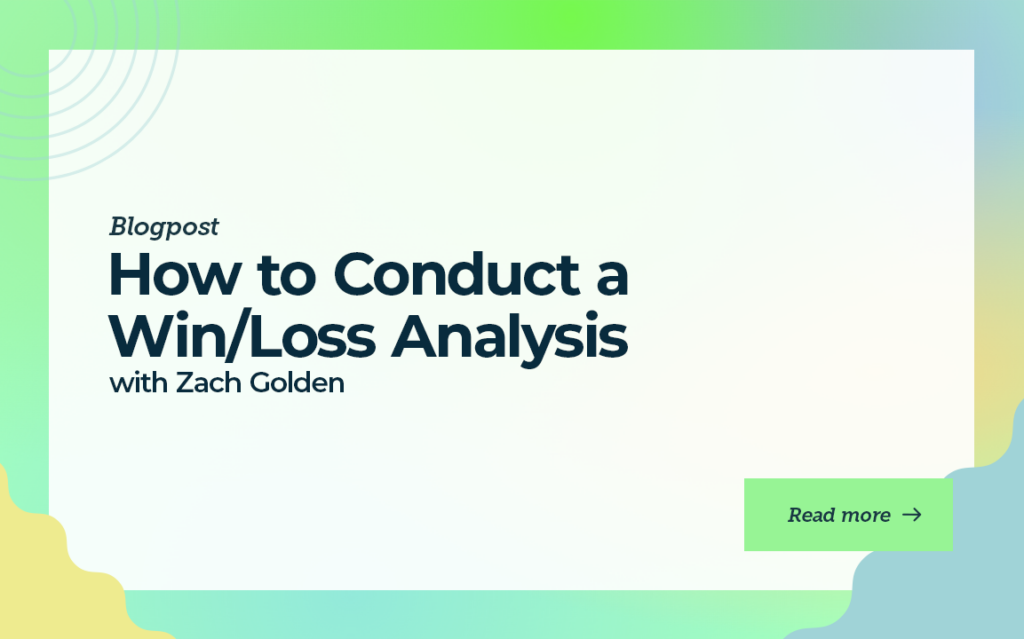How to Conduct a Win/Loss Analysis with Zach Golden

In this episode, Collin Stewart interviews Zach Golden, Director of Client Management at Anova Consulting Group, to uncover the value and intricacies of win-loss analysis in sales.
Although not widely adopted, win-loss analysis can significantly impact business growth by providing deep insights into why deals are won or lost.
The Journey into Win-Loss Analysis
Zach has dedicated the past decade to win-loss analysis, a field he describes as a powerful tool for answering fundamental business questions. By delving into detailed buyer feedback, win-loss analysis reveals nuanced insights into customer perceptions and competitive landscapes.
"Win-loss analysis answers the quintessential business questions: how do I grow my company, win more deals, understand customer opinions, and outsmart competitors."
Why Bother with Win-Loss Analysis?
Despite its benefits, few companies adopt win-loss analysis. Zach emphasizes its potential to increase sales revenue, citing Gartner studies that show revenue increases of up to 50%. However, only a small percentage of companies implement structured win-loss programs.
"Win-loss programs can help a sales team increase revenue by up to 50%, but only a small percentage of companies do it."Deep Dive into Customer Feedback
Practical win-loss analysis involves more than just collecting CRM data. It requires forensic-level interviews to understand buyer decisions and perceptions. Through in-depth interviews, companies can uncover hidden issues and improve customer-centricity.
"It's about a forensic exercise to understand what buyers think about your product and how they make decisions."Real-world Applications and Insights
Zach shares an example of a company that believed it was customer-centric but discovered, through win-loss analysis, that it wasn’t meeting customer expectations. By examining buyer satisfaction across various attributes, they realized the need to focus more on understanding and addressing customer needs.
"Despite high satisfaction with their product, customer-centric attributes like understanding needs and tailoring pitches were below 20% satisfaction."Navigating the Complexity of Sales Feedback
Win-loss analysis can reveal general themes like customer centricity and the relationship between price and value. Companies can better align their offerings with customer expectations by analyzing satisfaction ratings and understanding customer perceptions of value.
"We help clients see how satisfaction with their price point and expected value differs between wins and losses, guiding them to improve their value proposition."Uncovering Patterns in Win-Loss Analysis
Win-loss analysis reveals significant patterns in customer feedback. Companies can identify inconsistencies and areas for improvement by comparing feedback from wins and losses.
For instance, it’s crucial to understand why a win or loss occurred to address those issues and replicate successes.
Importance of Wins and Losses
Focusing solely on losses might seem beneficial since it provides constructive criticism. However, understanding why you win is equally important. Wins can highlight what your company does well and should continue doing.
Zach emphasizes the importance of comparing both to ensure consistency in messaging, sales approach, and product perception.
Common Sales Mistakes
Specific patterns consistently emerge in win-loss analysis:
- Lack of Customer Understanding: Not fully grasping the customer’s needs.
- Insufficient Differentiation: Failing to distinguish your product from competitors or the status quo.
- Poor Value Articulation: Struggling to convey your solution’s quantitative or emotional value.
Zach mentions these as the “Big 3” areas where companies often fall short. Addressing these can significantly enhance sales effectiveness.
Iterative Process
Effective win-loss analysis is iterative.
It requires ongoing adjustments and refinements to your sales approach based on continuous feedback. This iterative nature ensures companies can adapt and evolve their strategies to stay competitive.
Engaging with Feedback
Engaging with feedback requires readiness to accept both praise and constructive criticism. Before diving into win-loss analysis, companies must be culturally prepared to handle and act on the feedback received.
Tactical Implementation
Implementing a win-loss program involves several steps:
- Interview Design: Crafting questions that address critical areas while leaving room for customer-specific feedback.
- Interview Execution: Deciding who will conduct the interviews and ensuring they are objective and thorough.
- Building It into the Sales Process: Making win-loss analysis a standard part of the sales cycle to gather consistent and valuable insights.
Setting the Right Timing
Timing is crucial. Conducting win-loss interviews too soon after a decision can be counterproductive. Allowing some time to pass helps ensure more objective and constructive feedback.
Ideal Timing for Feedback Collection
To maximize the effectiveness of your win-loss analysis, Zach suggests conducting feedback interviews within a month of the decision. This timeframe ensures that the details remain fresh in the respondent’s mind while allowing emotions to settle, leading to more objective and constructive feedback. For larger, more complex deals, this period can extend to a quarter.
Professional Courtesy Over Incentives
Rather than heavily relying on incentives, leverage the professional courtesy established during sales. By pre-wiring feedback requests throughout the sales interactions, you set the expectation that you will seek their insights. This approach capitalizes on the mutual respect developed, making respondents more willing to participate.
Crafting an Effective Interview Guide
Designing a thoughtful interview guide is crucial:
- Flexibility: Avoid using a strict checklist. Instead, allow the conversation to flow naturally to uncover deeper insights.
- Buyer Journey Focus: Structure your questions to follow the buyer’s journey, from initial interest to final decision.
- Open-Ended Questions: Encourage respondents to provide detailed feedback by asking open-ended questions and using silence to prompt further elaboration.
Selecting the Right Interviewer
Choosing the right person to conduct win-loss interviews is vital. While salespeople can leverage their relationships, they may face biases that can affect the quality of the feedback.
Utilizing an unbiased third party or an internal team member who isn’t directly involved in the sales process often results in more candid and constructive feedback.
Holistic Understanding through Buyer Journey
The importance of understanding the entire buyer journey:
- Initial Trigger: Identify what initially brought the buyer to market.
- Evaluation Process: Explore how they evaluated different options, including your product.
- Perceptions and Comparisons: Gather their thoughts on your sales process, product features, and how you compare to competitors.
- Final Decision Factors: Understand the key reasons behind their final decision, whether they chose your product or a competitor’s.
Conducting Effective Interviews
The interview process involves several key steps:
- Recording and Transcription: It’s crucial to capture interviews accurately. Use call recording tools and transcription services to ensure all details are documented. Whether through advanced technology or traditional methods, detailed notes (like deposition examples in the legal industry) are essential.
- Active Listening: Engage in active listening during the interviews. This means understanding and probing deeper into the responses to extract valuable insights.
- Guided, Flexible Conversations: While having an interview guide is essential, maintaining flexibility in the conversation encourages more open and detailed responses. Avoid making it feel like a checklist.
Analyzing and Utilizing Feedback
After conducting the interviews, the next step is analyzing the feedback:
- Detailed Review and Sharing: Carefully review the transcriptions and recordings. Share these findings with relevant team members, such as sales and product teams, to get multiple perspectives.
- Coaching and Development: Use the feedback for coaching sessions. Approach these sessions constructively, focusing on improvement areas without assigning blame. This helps in fostering a culture of continuous learning and growth.
Encouraging Detailed Feedback
Create a comfortable environment for respondents to share their thoughts. Techniques such as asking probing questions and strategically using silence can help elicit more comprehensive feedback. This method provides richer insights and makes the respondent feel heard and valued.
Conversion Rates and Expectations
Expect conversion rates to vary based on the strength of the relationship and the sales process.
An independent third party like Anova Consulting typically sees around a 50-60% response rate. Stronger relationships often yield higher response rates, emphasizing building trust and rapport during sales.
Leveraging Technology for Analysis
Enhance the feedback analysis process:
- Automated Tools: Utilize AI for transcription and tagging to organize and analyze data efficiently.
- Aggregated Insights: Compile data into spreadsheets or specialized software to track metrics and identify patterns. This helps recognize trends and common themes, providing a clearer picture of performance.
Maintaining the Human Element
Despite technological advancements, human interaction remains crucial:
- Face-to-face interaction: Conduct feedback and coaching sessions through direct conversations to ensure a deeper understanding and more effective implementation of insights.
- Continuous Improvement: Regularly update your processes based on the insights gained. Encourage your team to see feedback as a personal and professional growth tool.
The Power of Human Interaction
While AI and technology play a significant role in modern win-loss analysis, the irreplaceable value of human interaction cannot be overstated. Human interviewers bring empathy, shared experiences, and nuanced understanding, which AI lacks.
These elements are crucial for building rapport and gaining deeper insights during interviews.
The Role of Empathy and Shared Experiences
Empathy and shared experiences enable interviewers to resonate with respondents personally. This connection allows for more honest and detailed feedback, as respondents feel understood and comfortable sharing their thoughts. The ability to relate through stories and experiences is a unique strength of human interviewers that AI cannot replicate.
Integrating AI for Efficiency
Despite its limitations, AI can enhance the win-loss analysis process by handling administrative tasks such as transcription, note-taking, and initial data analysis. This integration allows human interviewers to focus on meaningful interactions and active listening, making the feedback more valuable.
By leveraging AI for routine tasks, companies can ensure that their human resources are used where they matter most, engaging with clients and interpreting nuanced feedback.
Determining the Right Sample Size
The number of interviews required varies based on the size and nature of the business. A handful of interviews can provide significant insights for smaller companies, while larger companies might need more data points to identify meaningful trends. Generally, conducting 20 to 30 interviews can reveal strong, actionable patterns.
This sample size balances obtaining enough data to identify trends and managing the practicalities of conducting numerous interviews.
Acting on Feedback: Best Practices
Collecting feedback is only the first step. The actual value of win-loss analysis lies in analyzing and acting on this feedback:
- Sharing Insights: Distribute findings across teams, including sales, product, and marketing, to ensure everyone is aligned and informed.
- Collaborative Analysis: Hold meetings to discuss findings and agree on action items. Involving different perspectives can provide a more comprehensive understanding of the feedback and lead to more effective solutions.
- Continuous Improvement: Update strategies regularly based on feedback. Assign action items and track progress to ensure improvements are implemented effectively.
Addressing Non-Decisions and Stalled Deals
An emerging trend in win-loss analysis is dealing with no decisions or stalled deals. Understanding why buyers hesitate or delay decisions is crucial for tailoring strategies that encourage quicker, more definitive actions. Questions should explore shifts in priorities, internal changes, and possible improvements to prompt choices.
This approach helps in understanding the underlying causes of indecision and addressing them proactively.
Ensuring Effective Implementation
For a successful win-loss analysis program:
- Regular Reviews: Conduct reviews after several interviews to stay updated on trends and ensure that insights are acted upon promptly.
- Assigning Responsibility: Ensure each action item has an owner responsible for implementation and follow-up. This accountability is vital to ensuring that feedback leads to tangible improvements.
- Using Feedback for Coaching: Interview findings can be used to coach sales teams. Discuss specific scenarios to improve future performance and address identified weaknesses. This practical application of feedback helps continuously refine sales strategies and improve outcomes.
Conclusion
The win-loss analysis is a powerful tool that provides deep insights into why deals are won or lost. It helps companies refine their sales strategies and enhance customer satisfaction.
Businesses can uncover critical feedback that drives improvements by conducting thorough, unbiased interviews and leveraging technology for analysis. Implementing this analysis effectively involves timely interviews, collaborative feedback sharing, and continuous iteration to meet market needs.
Ultimately, win-loss analysis fosters a more customer-centric approach and a stronger competitive edge.
Discover how Anova Consulting Group and Zach Golden can help you unlock the power of win-loss analysis to grow your business and outsmart the competition.
Explore more strategies and insights to enhance your sales process by tuning into the Predictable Revenue podcast.
NO TIME TO READ?
Listen On:




